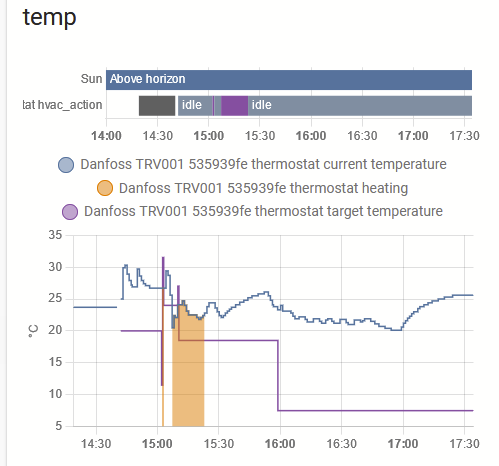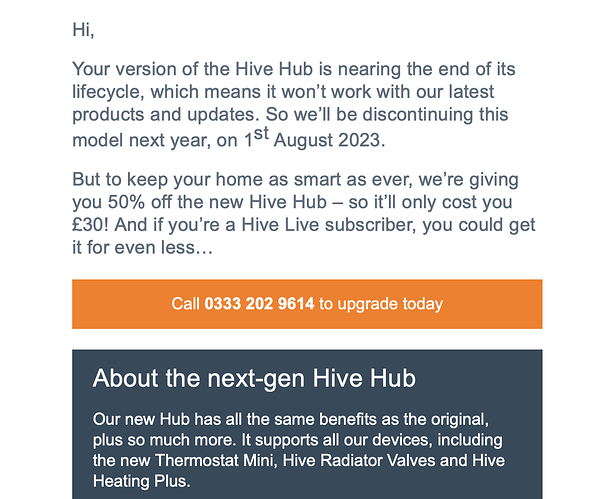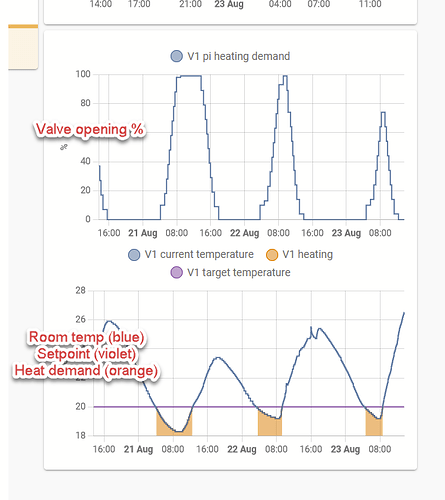So, British Gas also join the club of businesses deliberately making devices obsolescent. A perfectly functional Hub but BG want to make it obsolete. As the world becomes more ‘connected’ and the IoT grows, more unrepairable un-upgradable trash electronics will be created and essential devices are killed off earlier than necessary.
On the topic of IoT and repair, I came across this Repair Shop 2049 project recently: https://imagination.lancaster.ac.uk/project/the-repair-shop-2049/
The Repair Shop 2049 pilot project will focus on the limitations of the recently implemented Right-to-Repair legislation which does not account for the repair of Internet of Things (IoT) devices.
Not sure what their outputs are so far.
Hmm, there might be a market for a replacement for the hive hub that also removes the irritating Hive software. I’d rather pay someone who isn’t going to obsolete me again in another three or four years.
I see Hive products are lists here as using zigbee Database of Zigbee devices compatible with ZHA, Tasmota, Zigbee2MQTT, deCONZ, ZiGate and ioBroker (blakadder.com)
Might be time to get a zigbee adapter for my Raspberry Pi and figure out how to remove the hive hub from the equation completely, tell them to buzz off.
There’s openHAB software to run your smarthome, complete with iOS and android apps. See iOS App | openHAB
Software called ZigbeeMQTT Home | Zigbee2MQTT connects the zigbee protocol Hive parts to the openHAB controller software, using a Zigbee apadter plugged into a USB port of the Pi. Zigbee is a radio protocol allowing low-power communication over say 100m range which is plenty to cover your house. MQTT is a messaging protocol that works over any network on a publish-subscribe basis.
I’m sure it can’t be just as easy as it might seem, but does appear that the building blocks to reuse my Hive radiator valves, smart thermostat and the heading demand box attached to the boiler, with a replacement Pi-based hub are all there. Better get started before winter comes.
Keep us posted on the project @Ian_Barnard ! It would be good if there was a kind of OpenWrt type project for such hubs.
This discussion reminded me that we had a podcast episode on IoT and DIY smart homes a few years back:
featuring @Dave @Panda and @Andrew_Gabriel
AFAIK that’s pretty much what openHAB is https://www.openhab.org/ Describes itself as “a vendor and technology agnostic open source automation software for your home”
Just running the openHAB setup on my Pi now, quite nice it has a status page I can see what it’s doing just using a browser. Overall my biggest concern is that running home heating is a “production” environment where any downtime=>cold/unhappy/unshowered family, and I know SD cards have a finite life, so wondering if I’ll end up with something I have to reconfigure once a year whenever the SD card dies. Pi may be small, cheap and convenient but they’re not embedded systems which can (like the hive hub) be put on a shelf under the stairs and basically have nothing else go wrong until BG decide to obsolete them.
And of course I’m actively making my hive hub obsolescent, so this is robbing peter to pay paul IYSWIM.
Ordered a zigbeeMQTT-compatible zigbee adapter, £18 from ebay https://www.ebay.co.uk/itm/125049599699?mkevt=1&mkpid=0&emsid=e11050.m43.l1123&mkcid=26&ch=osgood&euid=a38846cebaa24222baf0151115076dee&bu=43113307151&osub=-1~1&crd=20220713192912&segname=11050 - other brands are available.
Fortunately I have a spare Hive smart radiator valve I can use to see if I can connect.
If I make progress I’ll let you know
The reply is that British Gas Hive hub is a complementary monitoring service.
So you pay the most to them to monitor the hub and keep you informed. If you buy your own solution, you don’t need to keep it up to date, as you are the only customer for your system. You can inform yourself if something is wrong, always the best solution!
We started off with just the water+heating wall thermostat, then added the smart radiator valves because the south side of our house is always warm during the day, and the north side almost unfailingly cool, i.e. a single thermostat never kept everyone happy. They work really well because they turn on the boiler+heating pump if a room gets too cool and heat it up - whereas a traditional thermostatic valve only stops the radiator heating if the room is too hot AND the heating pump is running, usually determined by a schedule and a single thermostat.
I just blocked my hive hub from the internet just to see what the impact of removing it might be. The radiator valves still work to demand heat, but the phone app shows blanks. The only loss from this (at the moment) is being able to change the schedules for each radiator. Can still adjust the temp of the radiators using the valve itself.
Next step will be to remove the hub completely (power it off) and see if the rads still work.
I figure as long as I find a way (through e.g. openHAB) to do scheduling then I can ditch the thermostat (which currently runs the schedules for overall heating/water) as well as the hub.
I turned off the hub. Checked a few minutes later and the radiator valve still worked! Means the valve must be paired to (I guess) the receiver by the boiler which turns on hot water heating/central heating, and not to the hub, which is what I was hoping.
At least it worked at first but now I’ve left it a few minutes instead of the set temperature it’s showing an error code looks like E8, and doesn’t operate. The wireless communication icon is flashing more often than I remember it doing before. Clears up if I remove the battery wait a few seconds and then put it back in. I’m suspicious this error might be range-related as I’m sat at the bottom of my garden in my home office and the boiler is at the other the other side of the house, so I’ll confirm by leaving the valve (it’s not attached to a radiator) near the boiler and see if I get the same error code.
Also will try removing batteries from the smart thermostat, as that’s another candidate for pairing with the radiator valves.
YES please keep update. Maybe put on Raspberry Pi website as well.
I’ve now switched from OpenHAB to Home Assistant (note I’m not associated with HA other than as a recently registered user), which seems at least to have history on their forum of more people interested in using Hive components without the hub and it’s necessary external cloud connection. E.g. https://community.home-assistant.io/t/is-it-possible-to-use-the-hive-app-with-the-hive-hub-and-attach-it-to-a-zigbee2mqtt-network/363373
HA has a full Hive integration which would talk to your account on the British Gas cloud servers, but these seem to sometimes be unavailable, or the API changes, e.g. recent addition of two factor authentication which broke the existing integration. The 2FA is one of the things driving me away from Hive - I’ve never yet required external access to adjust the heating system. If I did, there’s a Home Assistant cloud service which costs $6.50/month seems to want to be privacy-assuring https://www.nabucasa.com/
However zigbee2mqtt which interfaces the zigbee signals from the sensors into HA (via an MQTT broker called Mosquitto) already knows about Hive components although not sure yet whether the ones I have will be supported, but they can’t be very different. And this doesn’t need the hub or any external service - hurray! There seems to be at least 3 different thermostats (evolution of the product) and 3 or 4 different receivers (a mix of evolution and also two flavours supporting combi or non-combi boilers. Combi boilers have a single ‘demand’ circuit providing warmed water for taps or heating where non-combi tend to have one input to demand heating and another to demand hot water heating for the hot water tank.
To avoid having my heating/water out of action while I fiddle around, I’m acquiring some more Hive parts so I can set these up in parallel. Already got a spare smart TRV, have bought on ebay a pre-used ‘receiver’ (which is what makes the boiler turn on) and wireless thermostat, both very cheap, worth lurking and sniping for ![]() In a couple of days I’ll have a complete test environment. I imagine once the HA-based system is deployed and managing our water/heating I’ll sell these extra Hive parts (apart from the spare TRV) to at least cover the cost.
In a couple of days I’ll have a complete test environment. I imagine once the HA-based system is deployed and managing our water/heating I’ll sell these extra Hive parts (apart from the spare TRV) to at least cover the cost.
I’ve already got the TRV talking zigbee through the Sonoff Zigbee dongle to Home Assistant, in HA I can create any number of dashboards for different topics, and also serve these to the mobile app. I cna show the temperature of each valve, instantaneous and also historical, this wobbly line across the middle is my home office temperature from the TRV. The temperature goes down because I invested in a secondhand aircon unit last weekend so I don’t melt, and I manually turned the aircon on so I don’t get even close to melting. The purple line is the set temperature on the TRV, the orange area is I think where I turned that temperature above ambient so the valve turned on. Using Hive I can only get a graph like this for the thermostat not for each TRV, and if I wanted anything other than the last 24h then I’d have to subscribe.

I’ve integrated my HA setup to google calendars so I might be able to use that to set on/off times and temperatures for the hot water and heating. Hot water will be one calendar, wonder if I might have to have a calendar for each TRV (8, one per radiator), or find some way to group or encode the TRV name into a ‘meeting’ in a single Heating calendar. Longer-term I’m going to look for an alternative way of scheduling if possible, to avoid Google, to avoid need for an external service dependency on the internet.
So far the most complex steps have been burning the micro SD card for the PI with the Home Assistant pre-built image, and also getting Google Calendar to allow API access. Everything else is just browser pages ![]() Better start making some notes though otherwise I’ll forget a step.
Better start making some notes though otherwise I’ll forget a step.
Just discovered there’s a pre-packaged Home Assistant Yellow if you prefer/want/need to avoid the install steps.
More updates coming once I’ve got the parts I bought.
One of my target requirements is to address what AFAICT is missing from Hive, which is to use a combination of the amount of cloud and the difference between internal and external temperature to reduce the heating demand on sunny days so the heating doesn’t overshoot. On the southern side of our house it feels like we overheat on sunny winter days.
AFAICT Hive doesn’t take local weather conditions into account at all, this is something Google Nest seems (reportedly) to do better, and has a very attractive design of the thermostat itself, although IMO the wireless Hive thermostats are pretty slick.
But Nest seems to be targeted at US/North America because it’s designed for wired control of heating or of AirCon (i.e. heating and cooling) while Hive is designed for wireless installation of gas-fired heating systems, i.e. no cooling, which is very convenient for UK where you put the receiver at the boiler replacing the thermostat wiring and the wireless thermostat goes on a wall or surface wherever you want.
Latest update is that I just got my test hive-based heating system to turn on the heat (not actually, but it lights a green light and switches the relay that would demand heating if it were connected to a boiler) when the TRV set temperature exceeds the TRV local temperature. This has been a bit of a struggle. The key seems to be that the room thermostat has to be paired with the receiver for commands to the receiver to actually turn the heating channel on. All this is without the hub so no need for British Gas cloud account ![]()
Now I’ve got to figure out how to turn the heating off. One step at a atime.
IMO the thermostat isn’t much use once you have the smart TRVs because they each control the temperature of the room they’re in, not the single thermostat - was hoping not to have to use it, but couldn’t get the receiver to switch heating on without it paired, even though it’s not actually doing anything. Others seem to claim they don’t need the thermostat to get the receiver to work, but as I’ve got one anyway I’ll just put it in a drawer and it shouldn’t need to be touched. See https://community.home-assistant.io/t/can-i-integrate-hive-active-heating-into-ha-without-the-hive-hub/246728/19 and if you want the technical details of what the receiver SLR2b can supposedly do see https://www.zigbee2mqtt.io/devices/SLR2b.html - I say supposedly because I can’t get it to switch heating on when not paired to the thermostat.
Now I’ve got the thing switching heating on the net steps are figuring out how to turn it off (which should be easy just different values in the command sent) and then how to set up the scheduling/different temperatures at different times of day, which is rather more complex.
If you don’t have the smart TRVs then I think you can just pair the thermostat to the receiver and use the thermostat for scheduling hot water and heating without involving any Raspberry Pi or Home Assistant or anything. To use the Hive smart TRVs you either need a hub and BG account, or a setup like I’m trying to get working where Home Assistant is paired with the thermostats and controls the boiler.
My experience buying a hive receiver and thermostat on ebay is that with some patience and luck you can get them very cheaply - I paid a total of £25 for my test setup, compared to ~£160 new from Biritish Gas - noting you’ll need the skills or those of a friendly plumber to install the receiver which wires to your boiler - I already have these installed when our house was completely re-plumbed, IMO the hardest part is working out the existing boiler wiring to adapt it to the Hive receiver which will basically replace the old wired thermostat and heating timer connections. If you get a pre-owned hub you’ll have to also get the login transferred to your BG account to be able to use it, then you can use the Hive app.
Great work Ian,
Just reminds me to try and get my boiler Temp sensors working.
As you notice with boilers they have a temp differential which if maintained keeps heating working better ?. sometimes.
Should link up to my Solar Heating controller vis rPi.
Rgds Gordon.
Haven’t got quite so far as connecting to a real boiler. Actually I’m still having problems pairing the hive receiver (the bit that actually controls the boiler) with anything. Might end up using some zigbee relays instead, all it needs is two normally open relays one for heating one for hot water.
Interesting now I can watch the temperature sensors on the TRVs. The valves seem to openclose in ten steps, there’s a signal that shows this. What’s odd and doesn’t look nice is that when the temperature in increasing through the TRV setpoint temperature the valve stays partly open as the temperature continues to rise. This wouldn’t be a problem when there’s only one TRV in the system and it reaching the setpoint turns the boiler off so the pump stops, but if more than one TRV is demanding heat the pump will carry on running and any partly open valve will continue to let hot water into the radiator, so it will continue to increase the room temperature. That seems like exactly the issue I’ve felt - I get too hot even though the room temp has exceeded the setting on the valve.
The TRV is just sat on a desk by me, I guess when the TRV is on a real radiator it will warm up a lot quicker because it’s right by the rad, so turn off quicker. Hopefully that’s why this looks odd.
As you say if more than one TRV call for heat Boiler runs ! Thats how it should be. What also should happen is when TRV reaches temp it should SHUT ! Nice & simple. Rgds.

